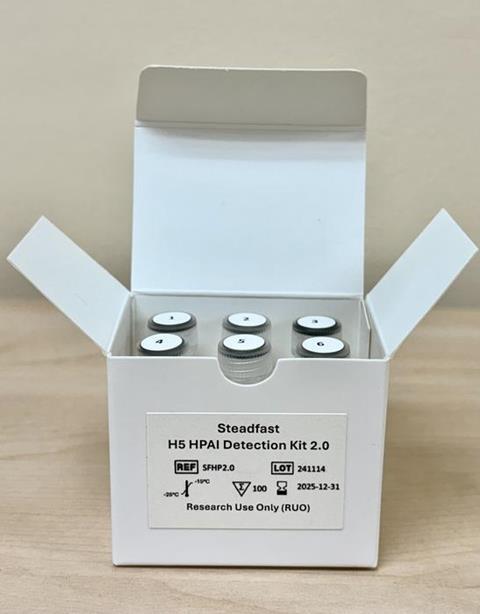The Diagnostics Development Hub (DxD Hub), a national platform hosted by the Agency for Science, Technology and Research (A*STAR), Singapore, in collaboration with the National Institute for Environmental Studies (NIES), Japan, and the A*STAR Bioinformatics Institute (A*STAR BII), has successfully developed Steadfast, an advanced diagnostic kit for detecting the highly pathogenic H5N1 Avian Influenza Virus (AIV). This development marks a significant breakthrough in avian influenza monitoring, reinforcing global efforts in pandemic preparedness.

Steadfast not only offers rapid detection of the highly pathogenic H5N1 avian influenza virus (AIV) but also distinguishes between highly pathogenic avian influenza (HPAI) and low pathogenic avian influenza (LPAI) strains, both of which are critical for effective control measures.
Unlike conventional sequencing methods, which take two to three days for results, this kit can detect HPAI H5 strains (H5N1, H5N5, H5N6) in as little as three hours. This swift detection is crucial for monitoring migratory birds, providing timely warnings, and reinforcing biosecurity at poultry facilities.
IDing the strain
HPAI strains, which are highly lethal and spread throughout the body of poultry, require immediate culling of affected flocks to prevent severe outbreaks. In contrast, LPAI strains are limited to the respiratory and gastrointestinal tract and cause mild symptoms, allowing for less drastic measures, such as enhanced monitoring and biosecurity. By enabling faster identification of the specific strain, the kit allows for more precise and timely responses, significantly reducing transmission risks and helping to prevent potentially devastating epidemics.
READ MORE: New initiative launched to advance mRNA vaccine development against human avian influenza (H5N1)
READ MORE: High H5N1 influenza levels found in mice given raw milk from infected dairy cows
The highly pathogenic H5N1 AIV is widely spread by birds, especially poultry, through direct contact, contaminated surfaces, or infected droppings. Migratory wild birds often carry the virus over long distances, transmitting it to domestic poultry populations where it can trigger severe outbreaks. Once infected, poultry act as reservoirs, potentially spreading the virus to other birds and, in rare cases, to humans who have close contact. Despite limited human transmission, H5N1 remains a critical global concern due to its high mortality rate and potential for mutation.
Prototype test kits
DxD Hub played a key role in the development of the multiplex assay prototype test kits, including the design and development of avian clinical testing protocols, data analysis, and assay optimisation. Validated by NIES, Japan’s primary laboratory for avian influenza testing in wild birds, the kit accurately classified avian influenza viruses detected in wild birds in Japan between 2022 and 2024 as either high or low pathogenicity.
A*STAR BII provided bioinformatics expertise in virus sequence, structure, and evolution analysis, supporting the integration of PCR diagnostics as a timely, cost-effective complement to genomic surveillance. This enabled more efficient detection and tracking of ongoing H5N1 outbreaks.
This close collaboration between DxD Hub, NIES and A*STAR BII was instrumental in refining the diagnostic kit’s functionality and ensuring its effectiveness in detecting both HPAI and LPAI strains in real-world clinical and field applications. This underscores the success of joint efforts to enhance detection and control measures for avian influenza, helping to curb the virus’s spread and safeguard public health.
Shared commitment
“DxD Hub is pleased to have collaborated with global ecosystem partners like NIES and A*STAR BII to develop the H5N1 Avian Influenza Virus diagnostic test kit. This achievement reflects our shared commitment to enhancing zoonotic diseases surveillance and pandemic preparedness,” said Dr Weng Ruifen, Chief Executive Officer of DxD Hub.
“Highly pathogenic avian influenza virus has caused mass mortality in chickens and wild birds not only in Japan but worldwide. Recently, infections have also been confirmed in seals, cats, cattle, and even from cattle to humans, drawing attention as a potential next pandemic virus.
”Such events highlight the virus’s rapid mutation, emphasising the importance of establishing an effective surveillance system and developing faster detection methods that can promptly adapt to virus mutation to prevent the spread of infection. The kit developed in our joint project meets this demand, and its widespread use is expected to alleviate public anxiety and allow for a more flexible response to the spread of infection,” said Dr Onuma Manabu, Head of the NIES Biodiversity Resource Conservation Office.
Evolving quickly and quietly
“A*STAR BII is pleased to be part of this joint effort and to support the development of this advanced AIV diagnostic kit by lending our expertise in virus bioinformatics. Viral genomes evolve extremely quickly and often quietly, making speed and accuracy — through more discerning surveillance and rapid detection — critical for containing potential infectious diseases outbreaks and minimising zoonotic spillovers.
”With this kit, we can better safeguard food security, public health and economic stability in Singapore and around the world,” said Dr Sebastian Maurer-Stroh, Executive Director of A*STAR BII.
Topics
- A*STAR Bioinformatics Institute
- Agency for Science, Technology and Research
- Asia & Oceania
- Clinical & Diagnostics
- Diagnostics Development Hub
- h5n1
- Infectious Disease
- Innovation News
- National Institute for Environmental Studies
- One Health
- ONUMA Manabu
- Rapid Diagnostics
- Sebastian Maurer-Stroh
- Steadfast
- Viruses
- Weng Ruifen







No comments yet